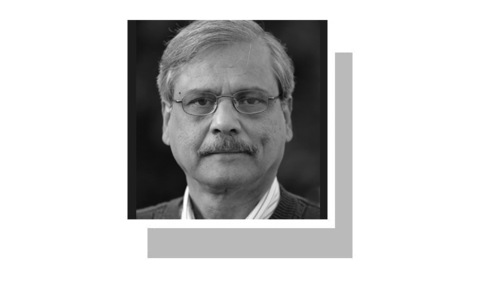
For a city drenched in history and encompassed by century-old structures, Lakshmi chowk ranks among Lahore’s top historical sites.
While care has been taken to sustain and restore several icons around the city, the Lakshmi façade –which stands at the core of Lakshmi chowk – has been altered without paying attention to its underlying aesthetics. The façade has been painted blue but what remains unclear is whether it is an attempt to revive the remains of the Lakshmi building or an act of contempt.
Located on McLeod road, which joins the famous Mall road and Abbott road, Lakshmi chowk has been for years the entertainment hub for the masses of Lahore. It existed long before the now famous M. M. Alam road and Food Street took their current shape. Apart from food, Lakshmi Chowk has been known as the heart of the Pakistani film industry.
The chowk gets its name from the Lakshmi building, which was built circa 1935 for commercial and residential purposes. In the pre-partition period, it hosted leaders of the Pakistan Movement and remained, for sometime after partition, the office of the Muslim League.
Later on, the Punjab Government declared it a protected building under Punjab Special Premises (Preservation) Ordinance of 1985. In violation of the act, the owners of the Lakshmi building sought permission from the provincial government to demolish the structure and rebuild it as a hotel to cater for Hindu tourists. However, the project has been put on hold after concerns arose regarding the building’s historical value.
Given its central location and non-stop activity, the building changes its shape as day turns into night. There is a marked fluctuation in activities that affects the overall experience – giving a dual personality to a single space. While in daytime it is abuzz with shoppers at its wide-ranging variety of shops and students from nearby colleges throng the crossroads, at night the cinemas come alive. Huge, well-lit billboards and posters showcase upcoming Lollywood hits, as well as the poster artisan’s craft. With Lahore and its inhabitants’ love for food knowing no bounds, the evening also brings with it the aroma of the cuisines being prepared out in the open.
Local authorities have replicated this day-to-night change by drastically changing Lakshmi building’s façade, which has deprived it of its historic value and taken away the charm of the building re-interpreting itself. The beauty of the structure was in the way it had gracefully aged. The once stark white color had become a tone of gray. The subtle mono-tone quality of the facade allowed for one to observe and marvel at the detail of the lotus motifs, the carved elephants, the windows, its arches, and the cornices that give it a sense of proportion. The eye was never struck by one thing or detail in particular. The facade worked all its details and proportions in harmony. Although grey and mono-tone, it stood out in all its glory, spoke of the culture it belonged to and the years it had lived.
In the recent intervention on the façade carcass, all the details have been painted a rather sharp tone of blue, while the remaining has been painted a slightly brown shade of white. The words 'Allah-hu-Akbar' have replaced the statue of the Lakshmi Goddess, almost as if to mock its original historical and cultural background. The Lakshmi façade makes strong visual references to Hindu mythology by way of its overall detailing. That being said, the presence of the takbeer on an evident Hindu image raises the question as to how distressed and insecure Muslims might have become as a community that they feel the need to impose their belief onto something that belongs to a completely different set of beliefs.
The facade which was once a treat to the eye has now become painful to look at. The details of the facade are no longer appreciable since it is now impossible to stare at the structure long enough. Had it been worked on with sensitivity, the Lakshmi façade stood a fair chance of being reintroduced to the chowk in today’s time, to today’s generation. A strong dialogue between the ‘old’ and the ‘new’ is needed, and painting the façade in no way addresses the subject at hand. The Lakshmi façade along with the other historical buildings on the chowk grant a sense of balance and stability to an otherwise haphazard and drastically changing surrounding. If taken away, the chowk will eventually lose its value.
The author is an architect, currently working with the Aga Khan Cultural Service Pakistan on the Walled City of Lahore.











































